



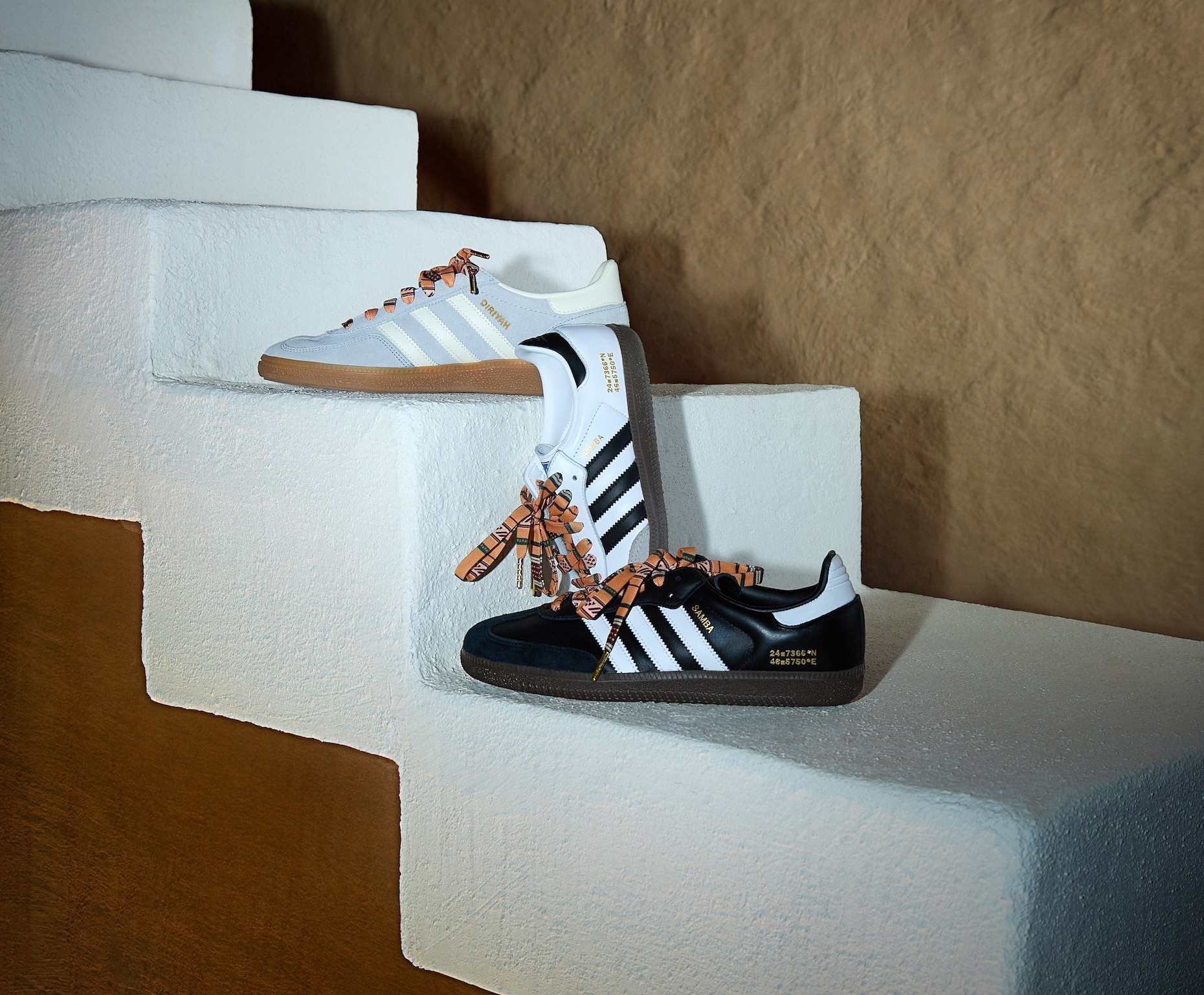
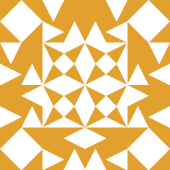
Following the exploration of lace as a vessel for storytelling and symbolism in our previous post about The Loomhood Collection, we now shift our focus to the heart of the UAE, KSA, and Egypt where these intricate crafts continue to embody the spirit of local heritage. In this chapter, we unravel the historical and cultural significance of these exquisite traditional crafts that had been an intrinsic part of garments and festive adornments – now reimagined through the bold lens of contemporary design. Readers will also be introduced to the master artisans and communities who sustain these crafts, as we examine how place, memory, and material come together in each meticulously woven thread.
Threading Identity: UAE and Talli
Tallī: (Turkish: tel – wire, string), Gulf Arab – a woven braided trimming made with metal wire, threads and ribbons often sewn on detachable panels used as embellishments. Other – (Synonym: tulle_bi_talli
Tūlle_bi_tallī: (French: Tulle – a city in France where fine material for veil was first made; Turkish: tel – wire; Synonym: tariq; talli; badla; khus_dozi ), series of small metal knots made on a woven net ground as embellishment. The term is commonly used in the North African Arab region specifically in Egypt.
In a region where textile traditions are inextricably woven into cultural identity, the intricate craft of talli
Tallī: (Turkish: tel – wire, string), Gulf Arab – a woven braided trimming made with metal wire, threads and ribbons often sewn on detachable panels used as embellishments. Other – (Synonym: tulle_bi_talli
Tūlle_bi_tallī: (French: Tulle – a city in France where fine material for veil was first made; Turkish: tel – wire; Synonym: tariq; talli; badla; khus_dozi ), series of small metal knots made on a woven net ground as embellishment. The term is commonly used in the North African Arab region specifically in Egypt. Tallī: (Turkish: tel – wire, string), Gulf Arab – a woven braided trimming made with metal wire, threads and ribbons often sewn on detachable panels used as embellishments. Other – (Synonym: tulle_bi_talli
Tūlle_bi_tallī: (French: Tulle – a city in France where fine material for veil was first made; Turkish: tel – wire; Synonym: tariq; talli; badla; khus_dozi ), series of small metal knots made on a woven net ground as embellishment. The term is commonly used in the North African Arab region specifically in Egypt.
Historically practiced by women, talli
Tallī: (Turkish: tel – wire, string), Gulf Arab – a woven braided trimming made with metal wire, threads and ribbons often sewn on detachable panels used as embellishments. Other – (Synonym: tulle_bi_talli
Tūlle_bi_tallī: (French: Tulle – a city in France where fine material for veil was first made; Turkish: tel – wire; Synonym: tariq; talli; badla; khus_dozi ), series of small metal knots made on a woven net ground as embellishment. The term is commonly used in the North African Arab region specifically in Egypt. Lamella: (Latin: lāmella or lāmina – plate), a flat strip of metal yarn used as embroidery thread.
What makes talli
Tallī: (Turkish: tel – wire, string), Gulf Arab – a woven braided trimming made with metal wire, threads and ribbons often sewn on detachable panels used as embellishments. Other – (Synonym: tulle_bi_talli
Tūlle_bi_tallī: (French: Tulle – a city in France where fine material for veil was first made; Turkish: tel – wire; Synonym: tariq; talli; badla; khus_dozi ), series of small metal knots made on a woven net ground as embellishment. The term is commonly used in the North African Arab region specifically in Egypt.
In the Gulf, these removable decorative panels became known as badlah
Bādlah: (Hindustani: badal – cloud from Sanskirt: vārdala – water; Synonym: tariq; talli
Tallī: (Turkish: tel – wire, string), Gulf Arab – a woven braided trimming made with metal wire, threads and ribbons often sewn on detachable panels used as embellishments. Other – (Synonym: tulle_bi_talli
Tūlle_bi_tallī: (French: Tulle – a city in France where fine material for veil was first made; Turkish: tel – wire; Synonym: tariq; talli; badla; khus_dozi ), series of small metal knots made on a woven net ground as embellishment. The term is commonly used in the North African Arab region specifically in Egypt. Tūlle_bi_tallī: (French: Tulle – a city in France where fine material for veil was first made; Turkish: tel – wire; Synonym: tariq; talli; badla; khus_dozi ), series of small metal knots made on a woven net ground as embellishment. The term is commonly used in the North African Arab region specifically in Egypt. Khus_dozi: (Persian: Khvosh – an Iranian province; dozi – needlework; Synonym: tariq; talli
Tallī: (Turkish: tel – wire, string), Gulf Arab – a woven braided trimming made with metal wire, threads and ribbons often sewn on detachable panels used as embellishments. Other – (Synonym: tulle_bi_talli
Tūlle_bi_tallī: (French: Tulle – a city in France where fine material for veil was first made; Turkish: tel – wire; Synonym: tariq; talli; badla; khus_dozi ), series of small metal knots made on a woven net ground as embellishment. The term is commonly used in the North African Arab region specifically in Egypt. Tūlle_bi_tallī: (French: Tulle – a city in France where fine material for veil was first made; Turkish: tel – wire; Synonym: tariq; talli; badla; khus_dozi ), series of small metal knots made on a woven net ground as embellishment. The term is commonly used in the North African Arab region specifically in Egypt.
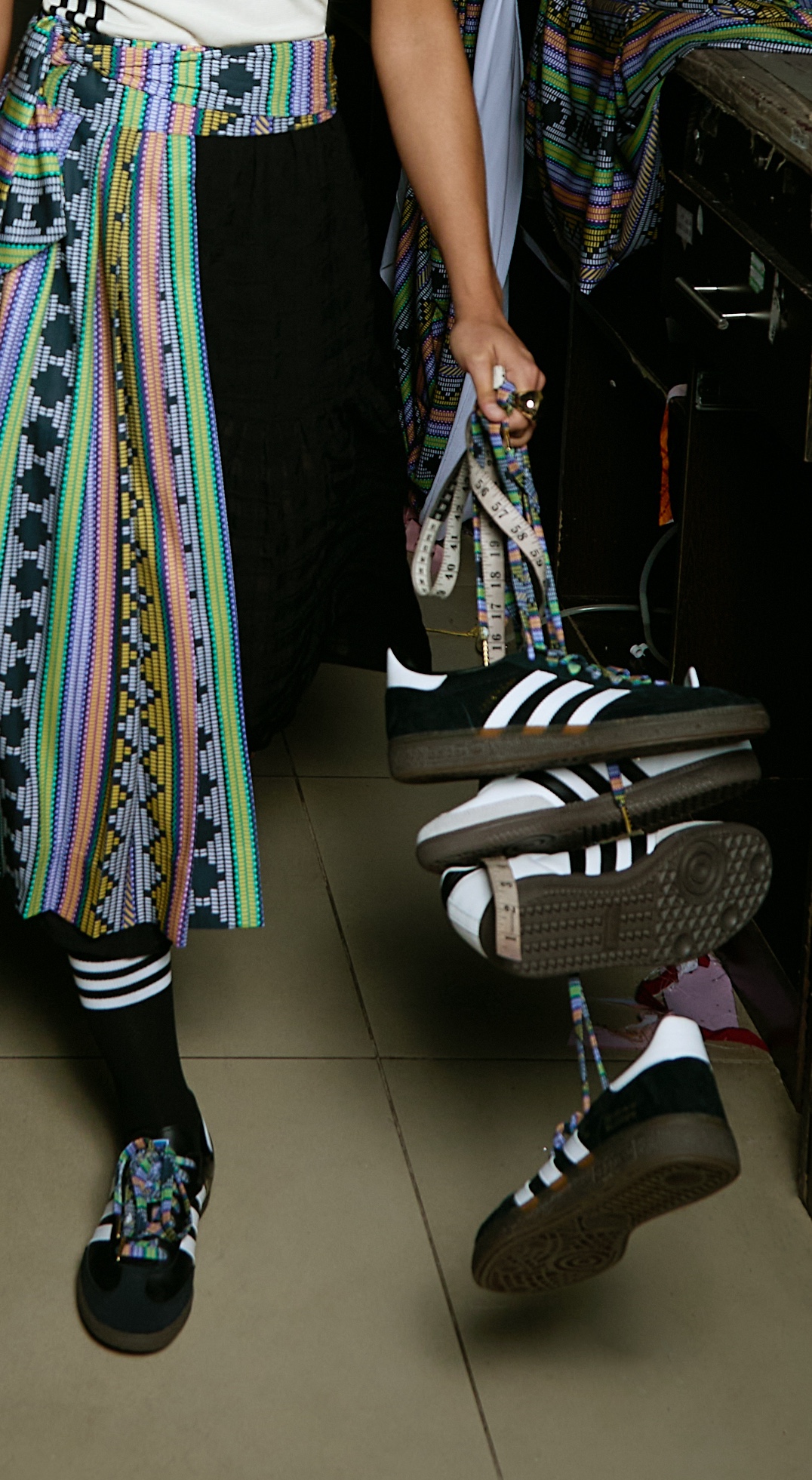 Talli
Talli
Tallī: (Turkish: tel – wire, string), Gulf Arab – a woven braided trimming made with metal wire, threads and ribbons often sewn on detachable panels used as embellishments. Other – (Synonym: tulle_bi_talli
Tūlle_bi_tallī: (French: Tulle – a city in France where fine material for veil was first made; Turkish: tel – wire; Synonym: tariq; talli; badla; khus_dozi ), series of small metal knots made on a woven net ground as embellishment. The term is commonly used in the North African Arab region specifically in Egypt.
Today, the art of talli
Tallī: (Turkish: tel – wire, string), Gulf Arab – a woven braided trimming made with metal wire, threads and ribbons often sewn on detachable panels used as embellishments. Other – (Synonym: tulle_bi_talli
Tūlle_bi_tallī: (French: Tulle – a city in France where fine material for veil was first made; Turkish: tel – wire; Synonym: tariq; talli; badla; khus_dozi ), series of small metal knots made on a woven net ground as embellishment. The term is commonly used in the North African Arab region specifically in Egypt. Tallī: (Turkish: tel – wire, string), Gulf Arab – a woven braided trimming made with metal wire, threads and ribbons often sewn on detachable panels used as embellishments. Other – (Synonym: tulle_bi_talli
Tūlle_bi_tallī: (French: Tulle – a city in France where fine material for veil was first made; Turkish: tel – wire; Synonym: tariq; talli; badla; khus_dozi ), series of small metal knots made on a woven net ground as embellishment. The term is commonly used in the North African Arab region specifically in Egypt.
In a striking homage to this Emirati heritage, adidas breathes new life into traditional talli
Tallī: (Turkish: tel – wire, string), Gulf Arab – a woven braided trimming made with metal wire, threads and ribbons often sewn on detachable panels used as embellishments. Other – (Synonym: tulle_bi_talli
Tūlle_bi_tallī: (French: Tulle – a city in France where fine material for veil was first made; Turkish: tel – wire; Synonym: tariq; talli; badla; khus_dozi ), series of small metal knots made on a woven net ground as embellishment. The term is commonly used in the North African Arab region specifically in Egypt. Tallī: (Turkish: tel – wire, string), Gulf Arab – a woven braided trimming made with metal wire, threads and ribbons often sewn on detachable panels used as embellishments. Other – (Synonym: tulle_bi_talli
Tūlle_bi_tallī: (French: Tulle – a city in France where fine material for veil was first made; Turkish: tel – wire; Synonym: tariq; talli; badla; khus_dozi ), series of small metal knots made on a woven net ground as embellishment. The term is commonly used in the North African Arab region specifically in Egypt.
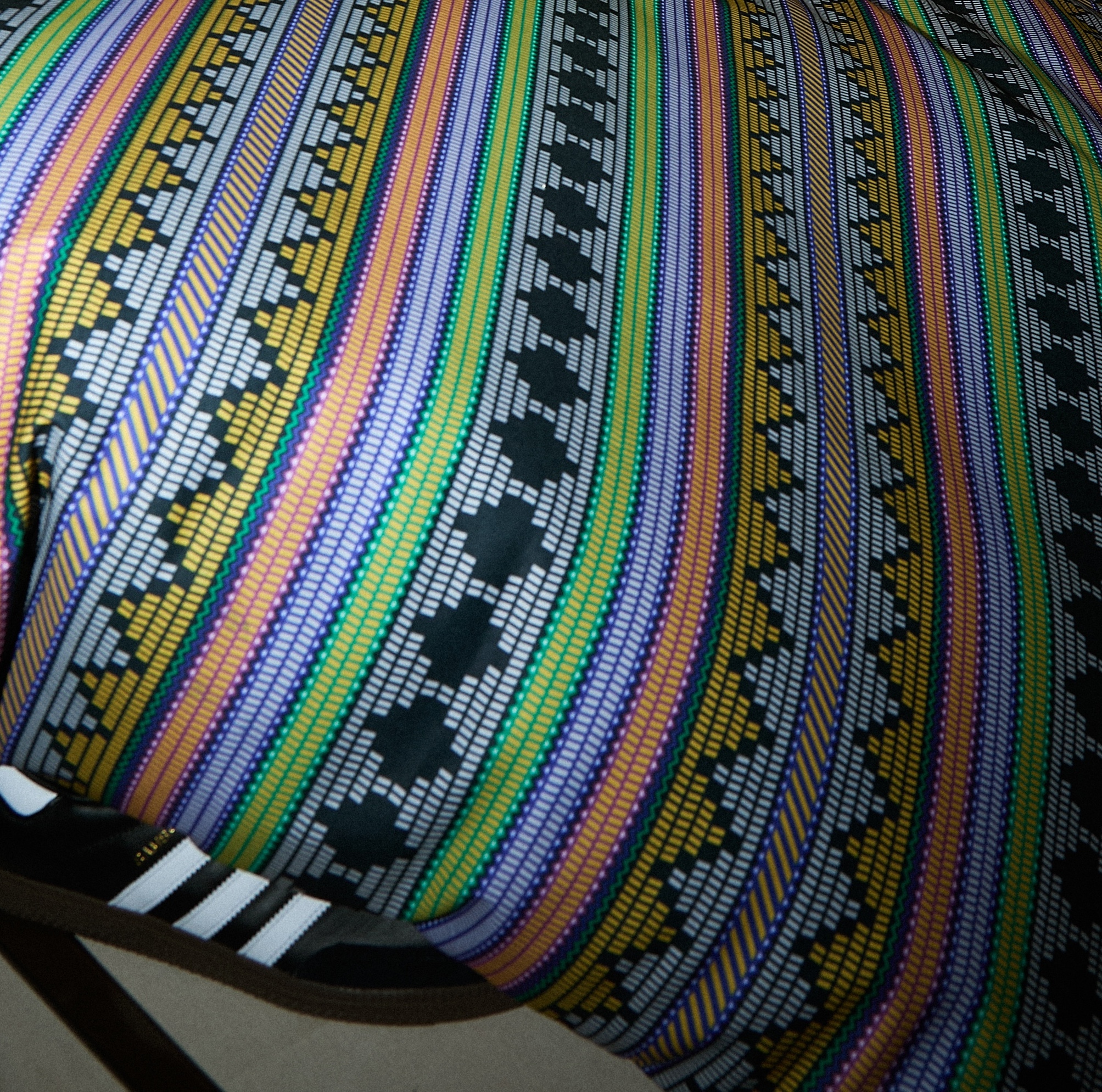 Talli
Talli
Tallī: (Turkish: tel – wire, string), Gulf Arab – a woven braided trimming made with metal wire, threads and ribbons often sewn on detachable panels used as embellishments. Other – (Synonym: tulle_bi_talli
Tūlle_bi_tallī: (French: Tulle – a city in France where fine material for veil was first made; Turkish: tel – wire; Synonym: tariq; talli; badla; khus_dozi ), series of small metal knots made on a woven net ground as embellishment. The term is commonly used in the North African Arab region specifically in Egypt.
Drawing from the visual language of this traditional trim, the collection features vivid hues that speak to a period of bold change, when artisans began experimenting beyond monochrome metallics to incorporate colour as a reflection of growth and modernity. These chromatic accents not only celebrate the evolution of talli
Tallī: (Turkish: tel – wire, string), Gulf Arab – a woven braided trimming made with metal wire, threads and ribbons often sewn on detachable panels used as embellishments. Other – (Synonym: tulle_bi_talli
Tūlle_bi_tallī: (French: Tulle – a city in France where fine material for veil was first made; Turkish: tel – wire; Synonym: tariq; talli; badla; khus_dozi ), series of small metal knots made on a woven net ground as embellishment. The term is commonly used in the North African Arab region specifically in Egypt.
 Talli
Talli
Tallī: (Turkish: tel – wire, string), Gulf Arab – a woven braided trimming made with metal wire, threads and ribbons often sewn on detachable panels used as embellishments. Other – (Synonym: tulle_bi_talli
Tūlle_bi_tallī: (French: Tulle – a city in France where fine material for veil was first made; Turkish: tel – wire; Synonym: tariq; talli; badla; khus_dozi ), series of small metal knots made on a woven net ground as embellishment. The term is commonly used in the North African Arab region specifically in Egypt.
Interwoven with these zigzag teeth patterns is the unmistakable adidas identity. The iconic three-stripe motif is subtly embedded within the geometry of the design, merging brand and tradition in a gesture of mutual respect and creative collaboration. The result is a design narrative that is both rooted and reimagined—a fusion where sportswear aesthetics meet the threads of cultural storytelling.
Earthen Echoes: KSA and Al Sadu
With its bold geometry and intricate symbolism, sadu weaving is more than just a textile tradition—it is a living record of nomadic life across the Arabian Peninsula. An ancient local craft that blends camel and goat hair with cotton and wool, Al Sadu weaves together threads of heritage, identity, and storytelling, offering a visual vocabulary that speaks to the rhythms of desert life.
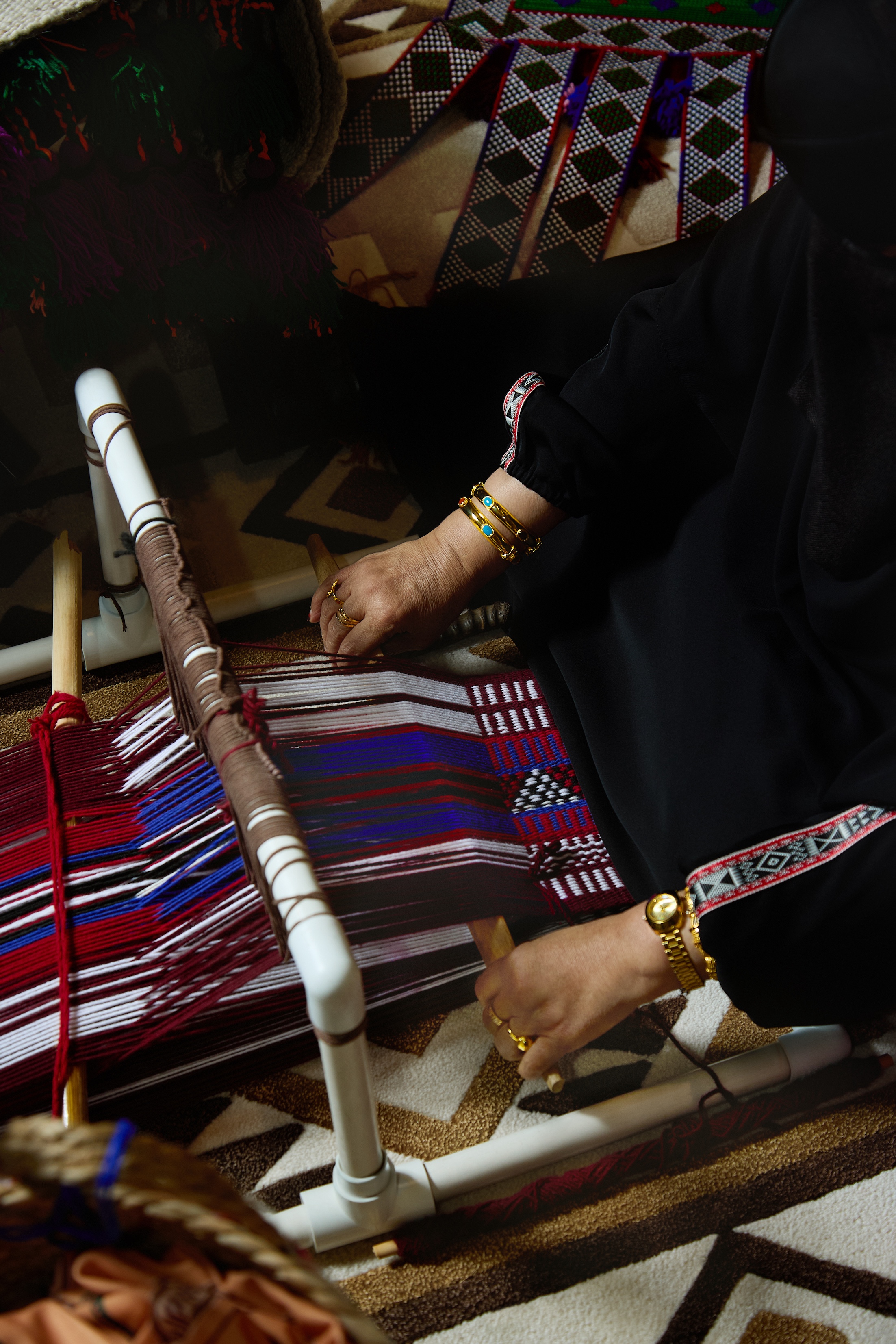 Traditional Sadu weaving in the quarters of Diriyah, Riyadh, Kingdom of Saudi Arabia; Credit: Raghe Farah
Traditional Sadu weaving in the quarters of Diriyah, Riyadh, Kingdom of Saudi Arabia; Credit: Raghe FarahPracticed predominantly by local women, sadu is deeply rooted in the gendered spaces of local society. Women, often gathering in small communal circles, pass down the techniques and motifs from one generation to the next, encoding their lived experiences into each warp Warp: One of the two basic components used in weaving which transforms thread or yarns to a piece of fabric. The warp is the set of yarns stretched longitudinally in place on a loom before the weft Weft: one of the two basic components used in weaving that transforms thread or yarns into a piece of fabric. It is the crosswise thread on a loom that is passed over and under the warp threads. is introduced during the weaving process. and weft Weft: one of the two basic components used in weaving that transforms thread or yarns into a piece of fabric. It is the crosswise thread on a loom that is passed over and under the warp threads.. Narrow woven bands—rich with repeating geometric forms—are meticulously stitched together to create functional textiles, from tent panels and cushions to storage and saddle bags, camel trappings and ceremonial garments.
Often hailed as both “The Birthplace of the Kingdom of Saudi Arabia” and “The City of Earth,” Diriyah stands as one of the Kingdom’s oldest and most storied oasis settlements. As a designated UNESCO World Heritage Site, Diriyah’s deep historical and cultural significance resonates through its landscapes and architecture. It is, therefore, no surprise that the city maintains some of the most intimate and enduring connections to the traditional craft of sadu weaving—a practice that is as much a visual language as it is a cultural lineage, woven into the very fabric of the region’s identity.
The designs themselves are far from ornamental. Each pattern, line, and colour carries distinct symbolic meaning, serving as visual narratives of local lineage, environmental conditions, and personal expression. From stars and mountains to desert flora and fauna, these motifs echo the intimate connection between the weaver and the land she inhabits. They also function as local identifiers—marking cattle, camels, or objects with symbols of belonging and pride.
Beyond its utilitarian purpose, sadu has emerged as a profound cultural emblem—one that reflects the adaptability, resilience, and aesthetic sophistication of the native communities. As contemporary efforts grow to preserve and recontextualize the practice within modern design and museum spaces, sadu continues to thread the past into the present, asserting its place not just in tents and textiles, but in the collective memory of a region shaped by sand, thread, and story.
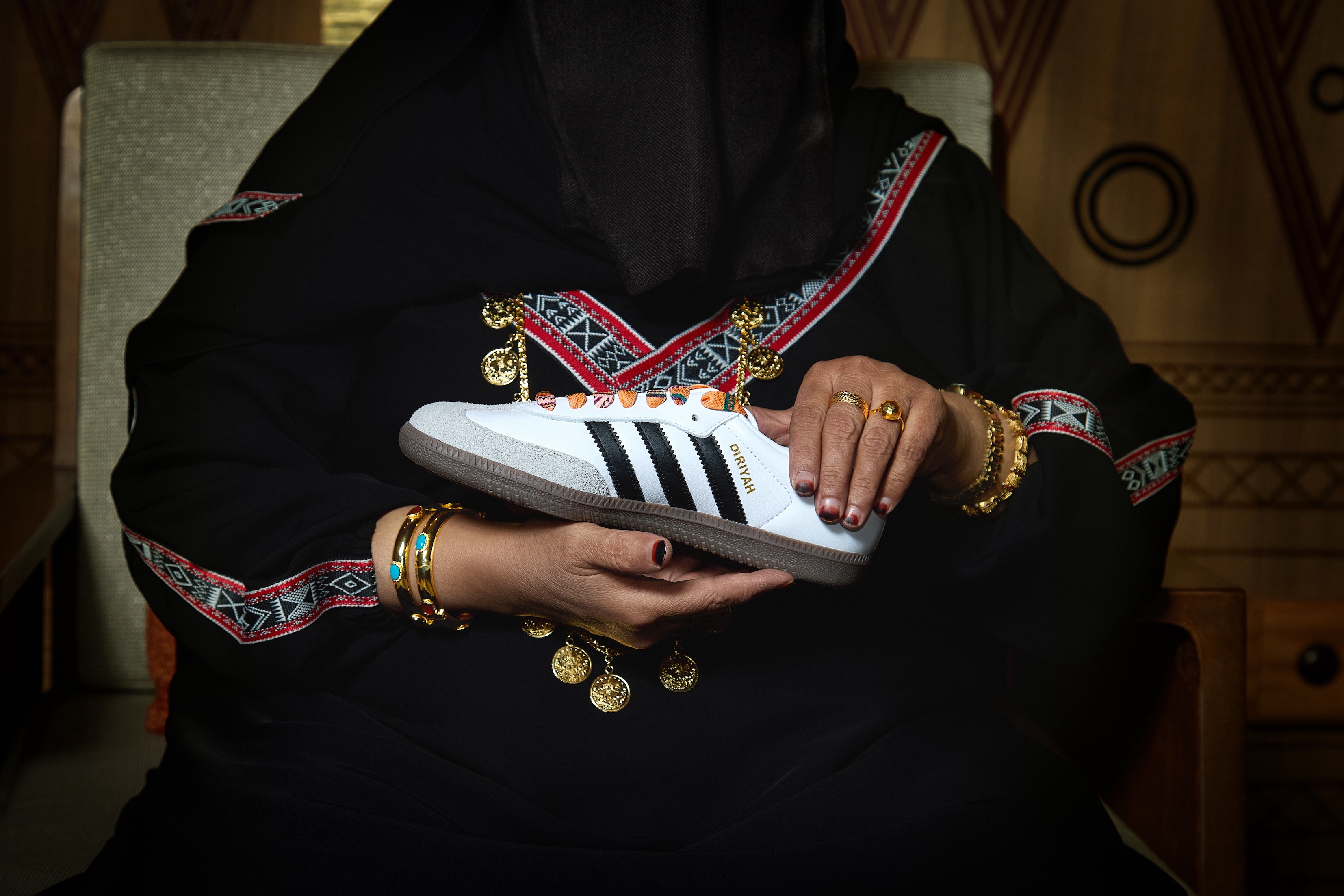 Sadu inspired laces on the shoes from The Loomhood Collection by adidas held by Rashida a seasoned sadu weaver from Diriyah, KSA; Credit: Raghe Farah
Sadu inspired laces on the shoes from The Loomhood Collection by adidas held by Rashida a seasoned sadu weaver from Diriyah, KSA; Credit: Raghe FarahRooted in the visual language of the native local traditions, adidas’ Loomhood Collection channels the soul of sadu textiles through a carefully curated palette and symbolic geometry. Honouring Rachida, a master weaver with over 30 years of experience in sadu weaving and remaining faithful to the craft’s distinctive earthen tones, the collection evokes the arid beauty of the desert landscape with hues of beige and brown, overlaid with deep maroons and reds—colours historically derived from natural dyes sourced from indigenous plants, animals, and even organic mordants such as cattle byproducts.
Triangular motifs—a hallmark of sadu weaving—are prominently featured, referencing the camel and the sand dune: two elemental symbols of nomadic life that anchor the local identity. These shapes, abstract yet deeply evocative, serve as cultural signifiers embedded within the fabric of the collection.
 Sadu inspired laces on the shoes from The Loomhood Collection by adidas; Credit: Raghe Farah
Sadu inspired laces on the shoes from The Loomhood Collection by adidas; Credit: Raghe FarahIn a subtle yet deliberate gesture, the adidas striped logo is seamlessly integrated into the pattern, becoming part of the textile’s narrative tapestry Tapestry: wall hanging or other large piece of fabric that is woven in coloured weft Weft: one of the two basic components used in weaving that transforms thread or yarns into a piece of fabric. It is the crosswise thread on a loom that is passed over and under the warp threads. threads or embroidered with a decorative design. Typically made of wool, but they can also be made of other materials such as silk, linen, or cotton. Often used to decorate homes, churches, and other buildings. . It is not merely branding, but a contemporary sigil woven into a dialogue between heritage and innovation—a celebration of ancestral artistry, reborn in motion.
Arabesque Flourish: Egypt and Khayamiya
With the Cairo chapter of its Loomhood Collection, adidas draws deeply from the intricate artistry of khayamiya—Egypt’s centuries-old appliqué textile tradition rooted in the grand narrative of its streets, mosques, markets, and ceremonial gatherings. Derived from the Arabic word khayma, meaning “tent,” khayamiya is more than craft; it is cultural theatre stitched in arabesque and calligraphy.
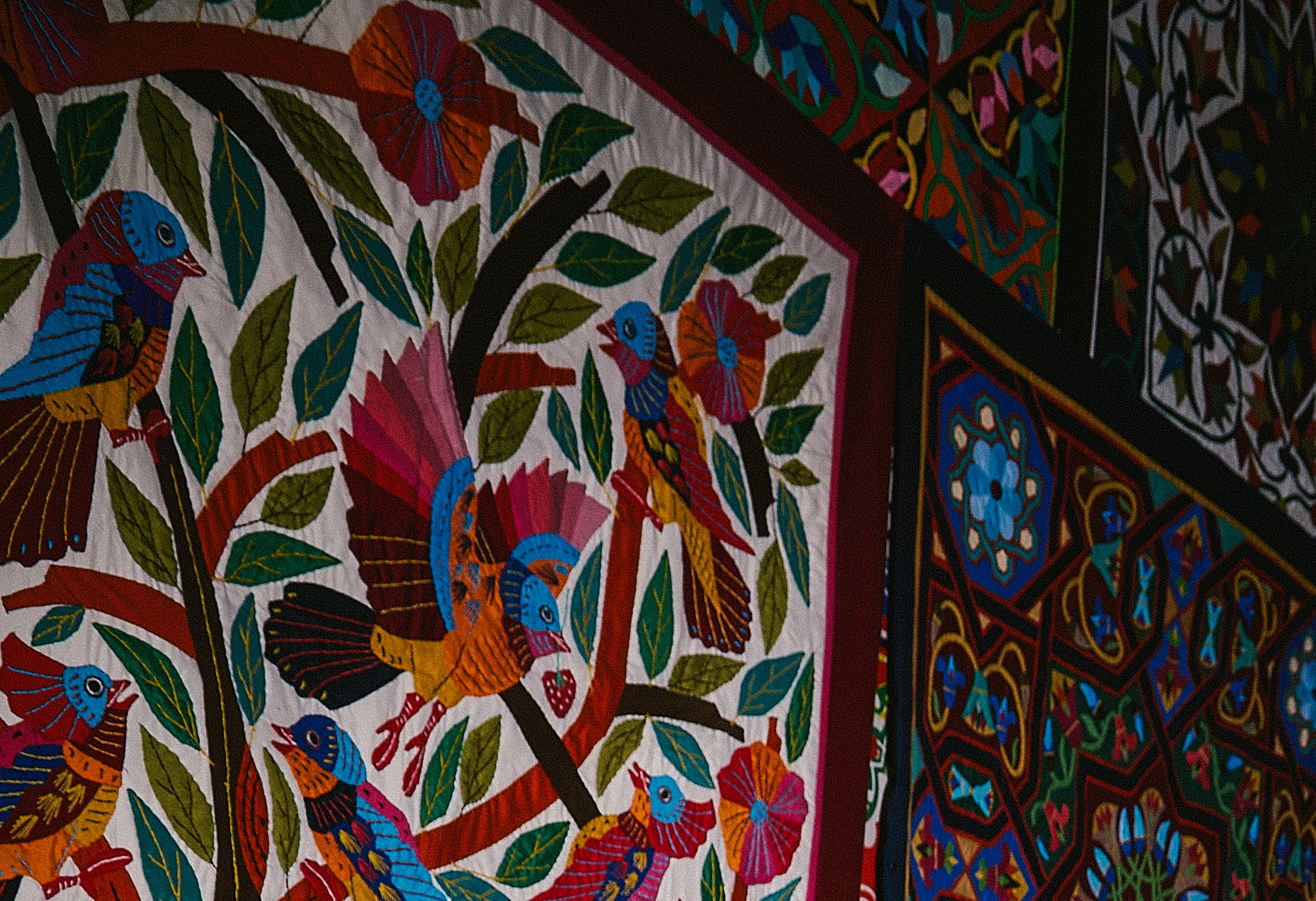 Khayamiya textiles on display in the markets of Shāri ‘al-Khayāmiyya, Cairo Egypt; Credit: Raghe Farah
Khayamiya textiles on display in the markets of Shāri ‘al-Khayāmiyya, Cairo Egypt; Credit: Raghe FarahTraditionally crafted by skilled artisans—khayami or khamiserie—the panels were hand-sewn from individually created motifs, forming vibrant canopies once used by royals, religious scholars, and ordinary families alike. From grand wedding receptions to poetry readings and funeral gatherings, khayamiya functioned as mobile architecture—textile pavilions for life’s most important rites.
Flourishing along the vibrant thoroughfare now known as Shāri ‘al-Khayāmiyya or Suq al-Khayāmiyy, the street pulses with the enduring spirit of Cairo’s artisanal legacy. Aptly named, this historic artery stands as a living gallery of craftsmanship, lined with multigenerational, family-run workshops whose storefronts continue to bear witness to the city’s deep-rooted tradition of textile artistry. Here, commerce and craft converge, where the hum of urban life meets the rhythm of the needle and thread.
Etched with etymological layers tracing back through Aramaic, Hebrew, and Ancient Egyptian, the term khayma reflects a historical continuity of sacred space—alter-chapel, covering cloth, and now, a cultural icon. In Cairo’s streets, it evolved from decorative shop awnings into public art—infused with literary flair as local artisans embroidered verses from contemporary poets and writers into their arabesque tapestries.
For the Loomhood Collection, adidas reimagines these heritage motifs on the laces, subtly embedding its iconic Trefoil logo within arabesque flourishes inspired by this centuries old craft of Cairo. At the heart of this homage is Mohsen Shaaban, a master (ustād) craftsman who has endeavoured to keep the tradition thriving for over half a century.
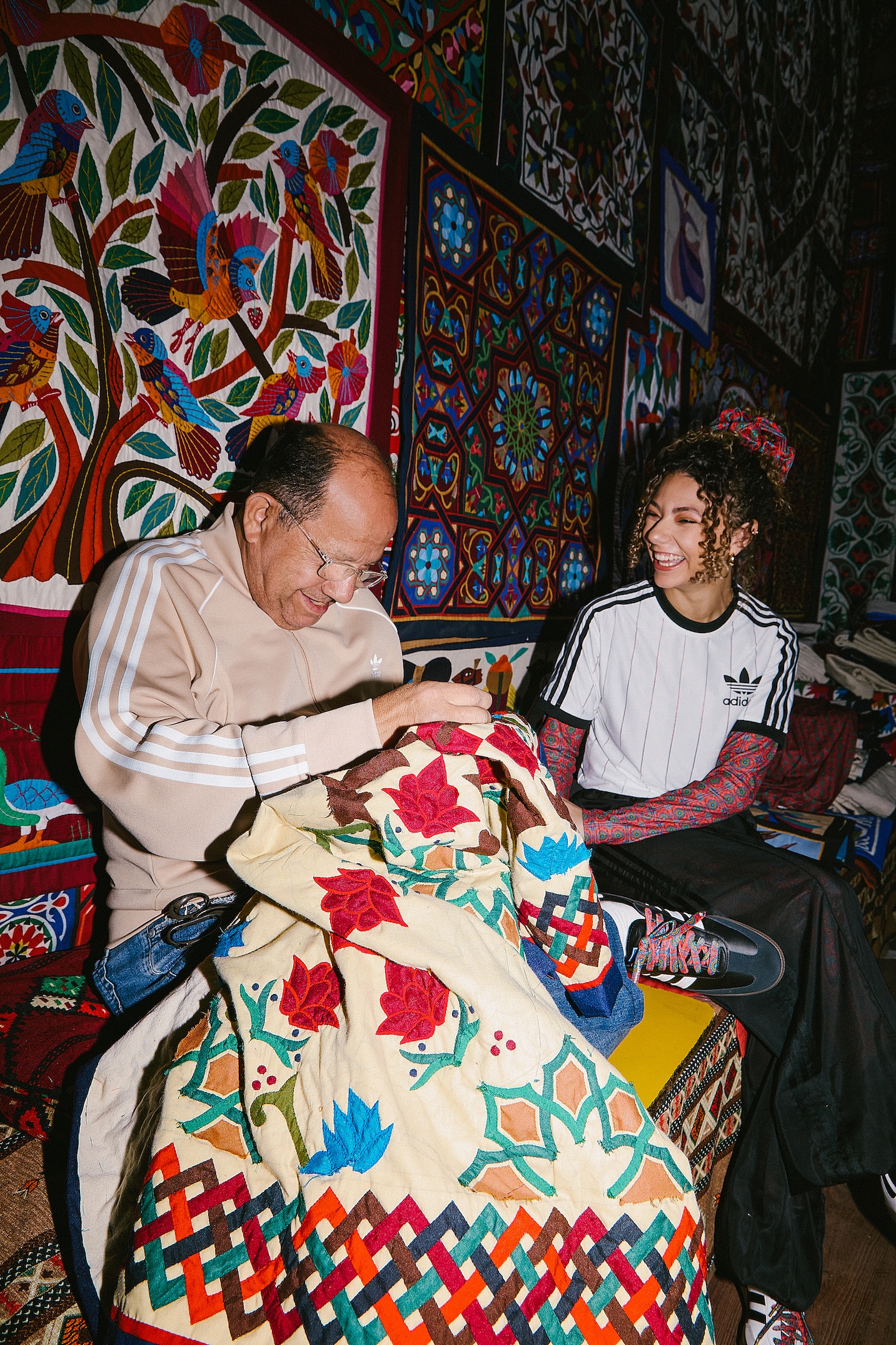 Mohsen Shaaban the master khyamiya artist from Shāri ‘al-Khayāmiyya, Cairo Egypt, displaying his skills while his khayamiya inspired patterns for laces adorn the shoes from The Loomhood Collection by adidas; Credit: Raghe Farah
Mohsen Shaaban the master khyamiya artist from Shāri ‘al-Khayāmiyya, Cairo Egypt, displaying his skills while his khayamiya inspired patterns for laces adorn the shoes from The Loomhood Collection by adidas; Credit: Raghe FarahIn an era increasingly defined by mass production and cultural homogenization, adidas’ latest endeavour is a timely and thoughtful reminder: behind every piece of craft lies a community, a history, and a future worth celebrating.
 Khayamiya inspired laces on the shoes from The Loomhood Collection by adidas; Credit: Raghe Farah
Khayamiya inspired laces on the shoes from The Loomhood Collection by adidas; Credit: Raghe FarahWith the Loomhood Collection, adidas delivers more than footwear—it offers a tactile narrative woven with reverence and precision. At its core, the collection is an eloquent fusion of tradition and innovation, a design philosophy that resists pastiche and instead chooses to honour heritage by embedding cultural codes into every visual and material detail.
Rather than replicating the past, adidas channels its spirit—translating centuries-old artisanal techniques into contemporary design language. The result is a collection that doesn’t merely draw inspiration from craft traditions but actively participates in their continuation. Every stitch, pattern, and hue serves as a tribute to communities and craftspeople who have preserved their knowledge through generations.
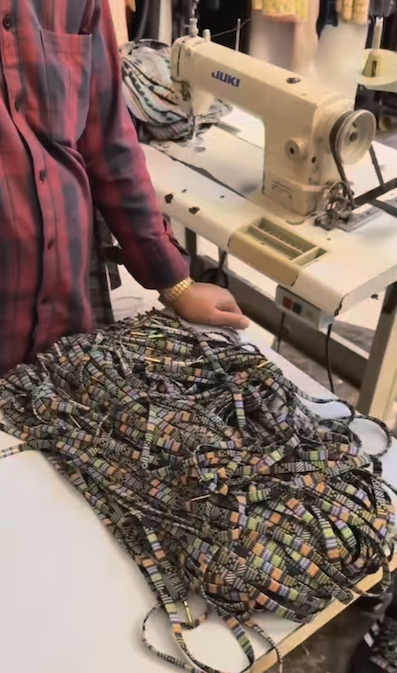
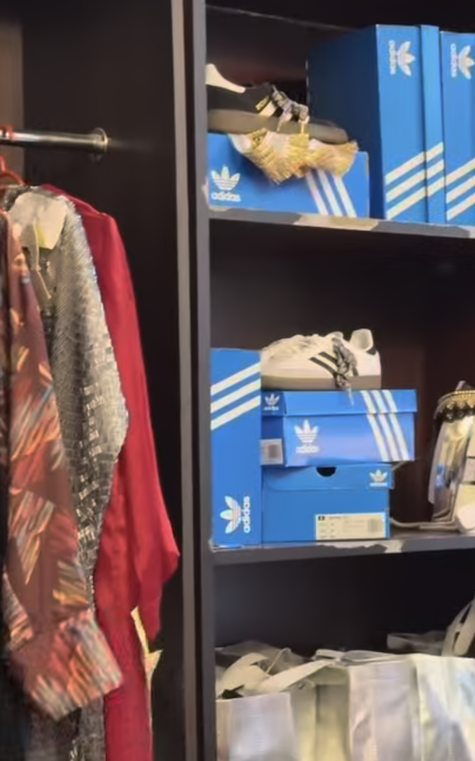
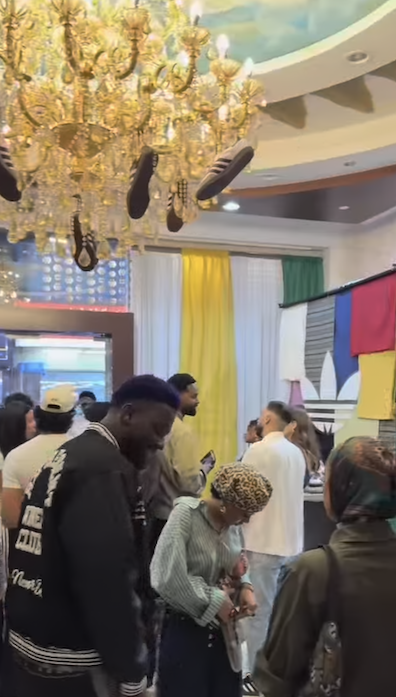
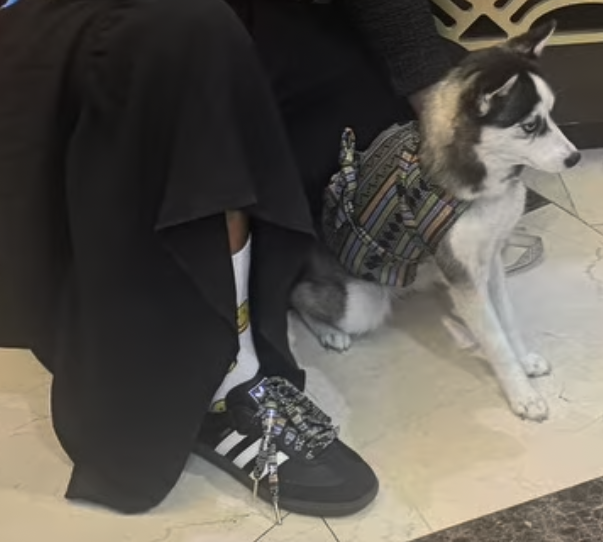
Tallī: (Turkish: tel – wire, string), Gulf Arab – a woven braided trimming made with metal wire, threads and ribbons often sewn on detachable panels used as embellishments. Other – (Synonym: tulle_bi_talli
Tūlle_bi_tallī: (French: Tulle – a city in France where fine material for veil was first made; Turkish: tel – wire; Synonym: tariq; talli; badla; khus_dozi ), series of small metal knots made on a woven net ground as embellishment. The term is commonly used in the North African Arab region specifically in Egypt.
In doing so, adidas builds a powerful bridge between the high-performance world of sportswear and the enduring grace of textile artistry. The Loomhood Collection is a testament to how heritage can evolve without erosion, resonating through each fibre as a celebration of memory, identity, and innovation. Here, artisans are not simply collaborators—they are cultural archivists, entrusted with the custodianship of visual and poetic legacies.
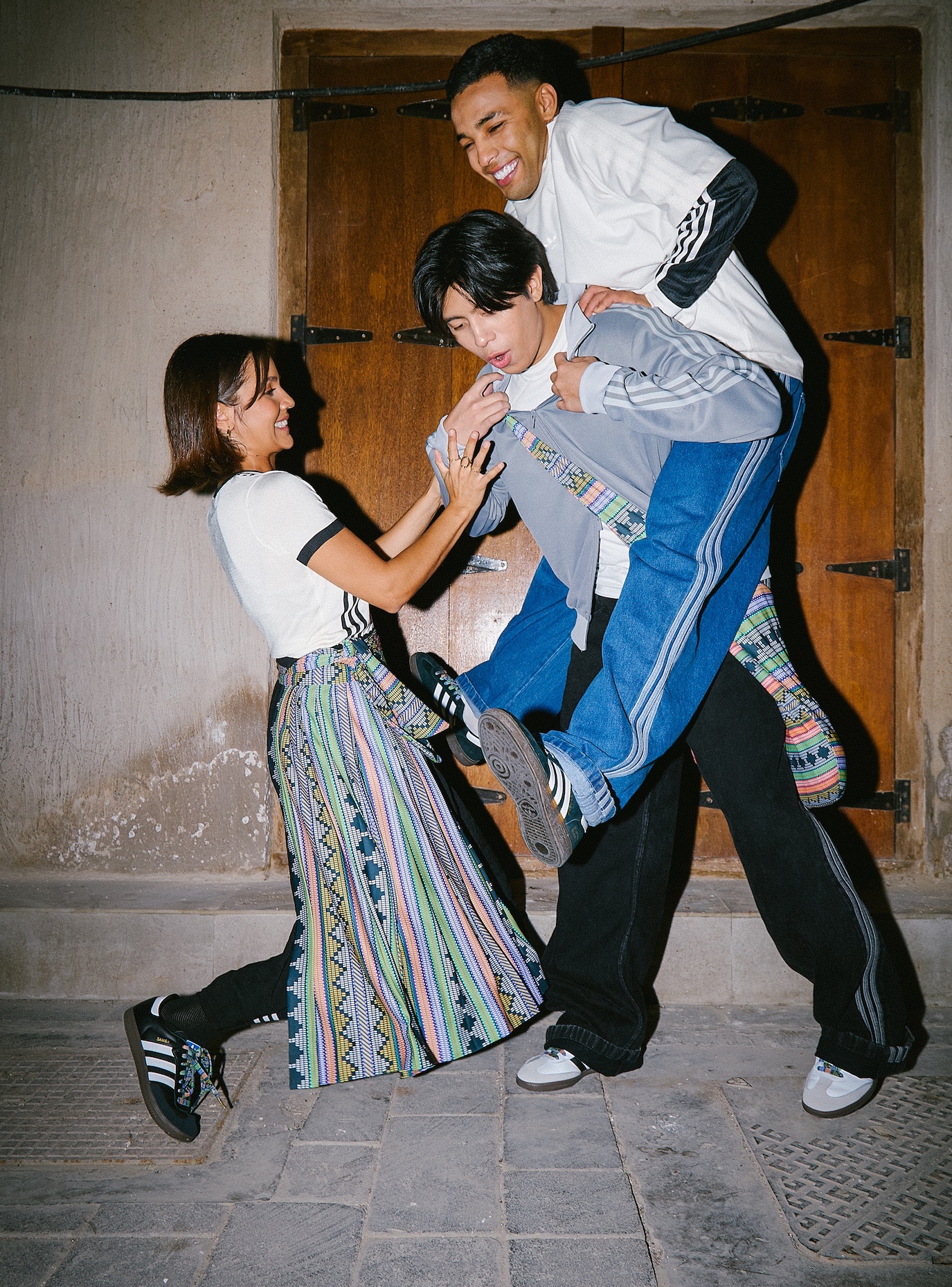 Shoes from The Loomhood Collection by adidas adorned with patterned laces inspired from traditional crafts; Credit: Raghe Farah
Shoes from The Loomhood Collection by adidas adorned with patterned laces inspired from traditional crafts; Credit: Raghe FarahWith the Loomhood Collection, adidas doesn’t simply reference tradition—it threads it into the fabric of contemporary streetwear, inviting wearers to step into a lineage of craft, colour, and cultural pride. At its core, the collection is more than a limited release—it is a statement of cultural appreciation, storytelling through design, and a reminder that heritage can live and breathe not just in museums and archives, but on the streets of the world, one step at a time.
The project is both a reflection and a call—to honour the places where hands, heritage, and history continue to shape the future.